SSC113: Applied Qualitative Research on Gender Based Domestic Violence
VerifiedAdded on 2022/10/17
|15
|2225
|421
Report
AI Summary
This report presents a qualitative research study on gender-based domestic violence, examining the association between alcohol and intimate partner violence. The research employs a grounded theory approach, analyzing secondary data from ten research papers. The study investigates the frequency of key terms like 'violence,' 'domestic,' 'abuse,' and 'women,' using descriptive and cluster analysis within the Nvivo environment. The findings reveal a strong correlation between alcohol consumption and violence, as well as intimate partner violence and substance abuse. Two theories are proposed: one suggesting an association between substance abuse and gender-based domestic violence, and another highlighting differences in rates of gender-based violence. The report concludes by emphasizing the global nature of intimate partner violence and the need to address factors like substance and alcohol abuse to combat this social issue.
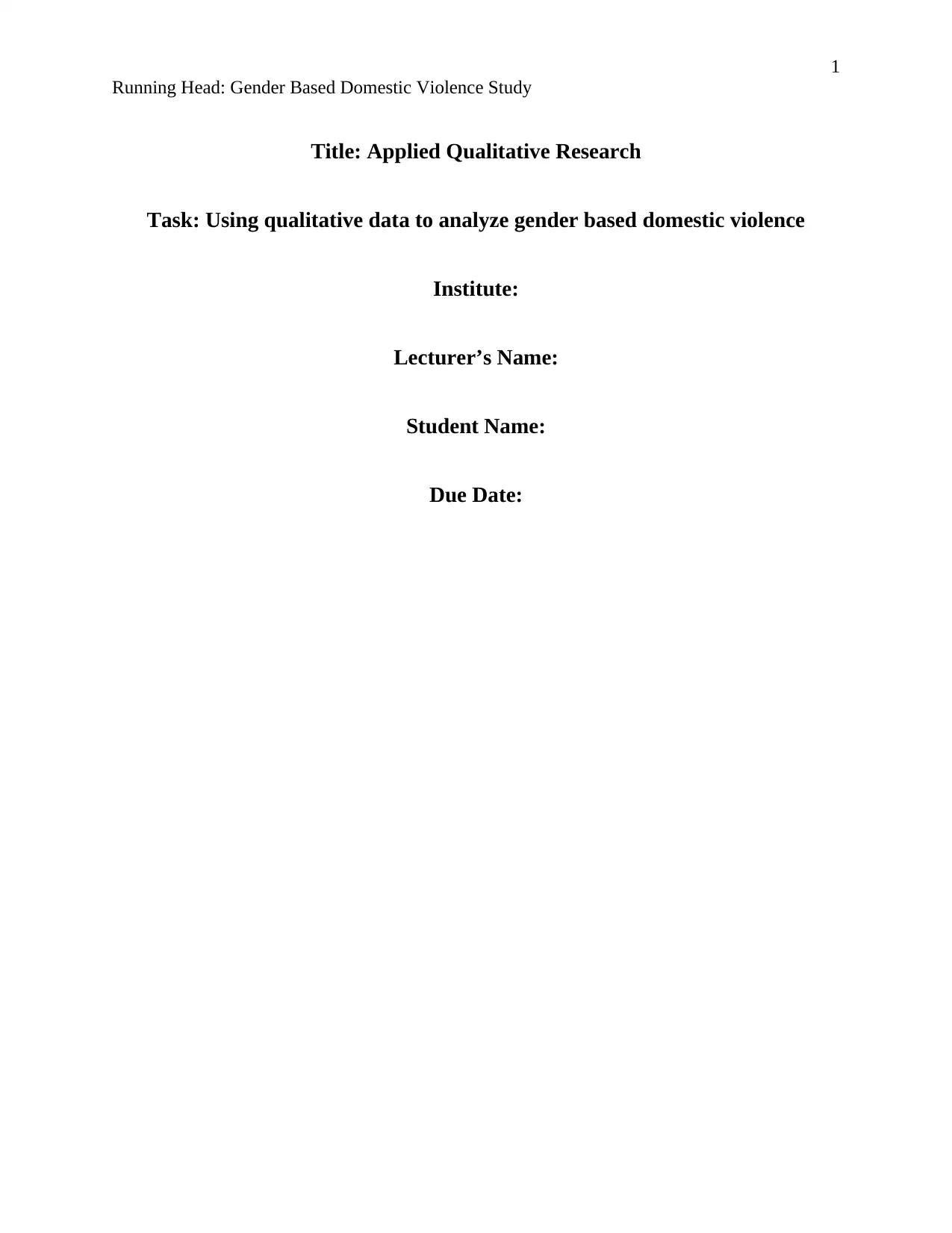
1
Running Head: Gender Based Domestic Violence Study
Title: Applied Qualitative Research
Task: Using qualitative data to analyze gender based domestic violence
Institute:
Lecturer’s Name:
Student Name:
Due Date:
Running Head: Gender Based Domestic Violence Study
Title: Applied Qualitative Research
Task: Using qualitative data to analyze gender based domestic violence
Institute:
Lecturer’s Name:
Student Name:
Due Date:
Paraphrase This Document
Need a fresh take? Get an instant paraphrase of this document with our AI Paraphraser
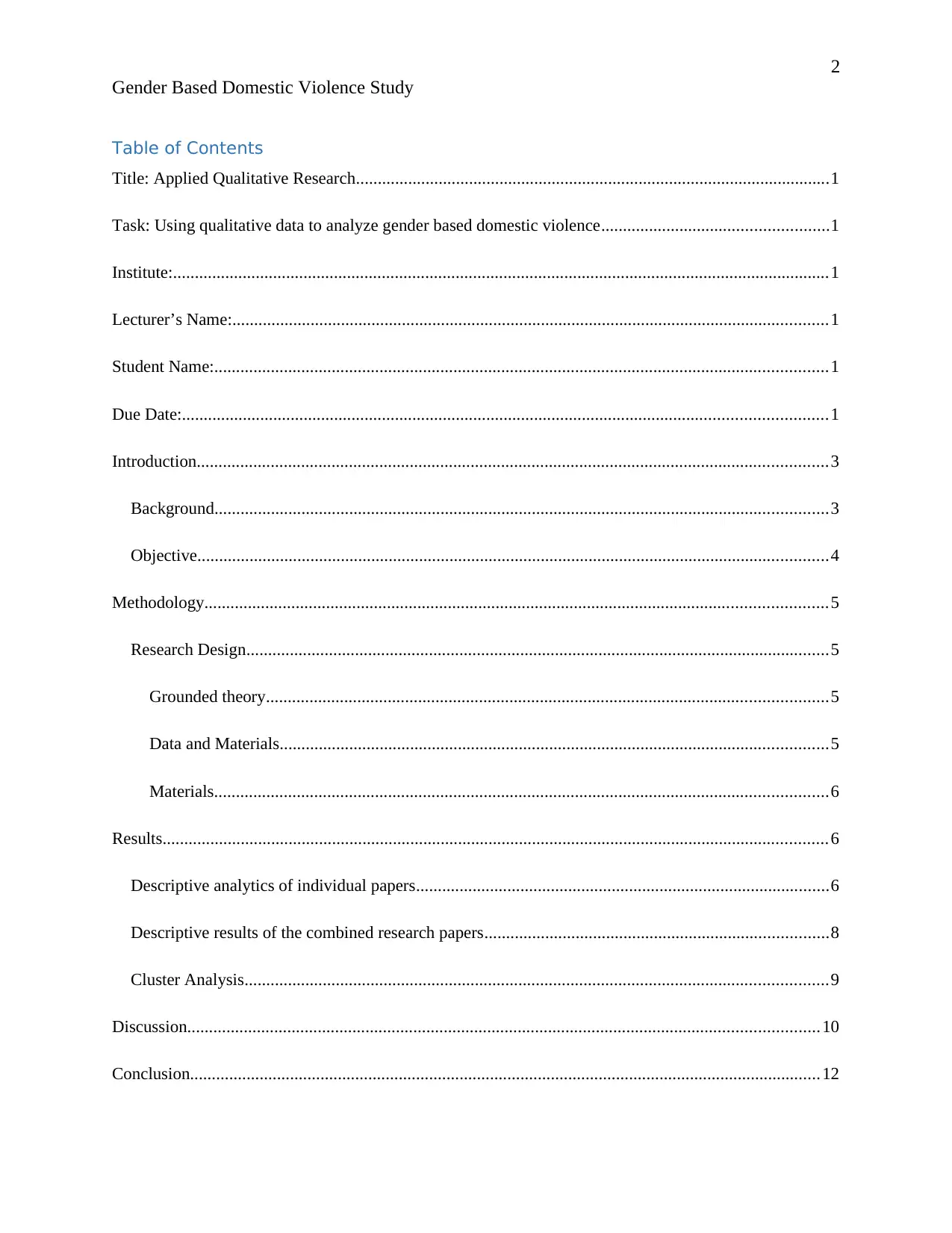
2
Gender Based Domestic Violence Study
Table of Contents
Title: Applied Qualitative Research.............................................................................................................1
Task: Using qualitative data to analyze gender based domestic violence....................................................1
Institute:.......................................................................................................................................................1
Lecturer’s Name:.........................................................................................................................................1
Student Name:.............................................................................................................................................1
Due Date:....................................................................................................................................................1
Introduction.................................................................................................................................................3
Background.............................................................................................................................................3
Objective.................................................................................................................................................4
Methodology...............................................................................................................................................5
Research Design......................................................................................................................................5
Grounded theory.................................................................................................................................5
Data and Materials..............................................................................................................................5
Materials.............................................................................................................................................6
Results.........................................................................................................................................................6
Descriptive analytics of individual papers...............................................................................................6
Descriptive results of the combined research papers...............................................................................8
Cluster Analysis......................................................................................................................................9
Discussion.................................................................................................................................................10
Conclusion.................................................................................................................................................12
Gender Based Domestic Violence Study
Table of Contents
Title: Applied Qualitative Research.............................................................................................................1
Task: Using qualitative data to analyze gender based domestic violence....................................................1
Institute:.......................................................................................................................................................1
Lecturer’s Name:.........................................................................................................................................1
Student Name:.............................................................................................................................................1
Due Date:....................................................................................................................................................1
Introduction.................................................................................................................................................3
Background.............................................................................................................................................3
Objective.................................................................................................................................................4
Methodology...............................................................................................................................................5
Research Design......................................................................................................................................5
Grounded theory.................................................................................................................................5
Data and Materials..............................................................................................................................5
Materials.............................................................................................................................................6
Results.........................................................................................................................................................6
Descriptive analytics of individual papers...............................................................................................6
Descriptive results of the combined research papers...............................................................................8
Cluster Analysis......................................................................................................................................9
Discussion.................................................................................................................................................10
Conclusion.................................................................................................................................................12
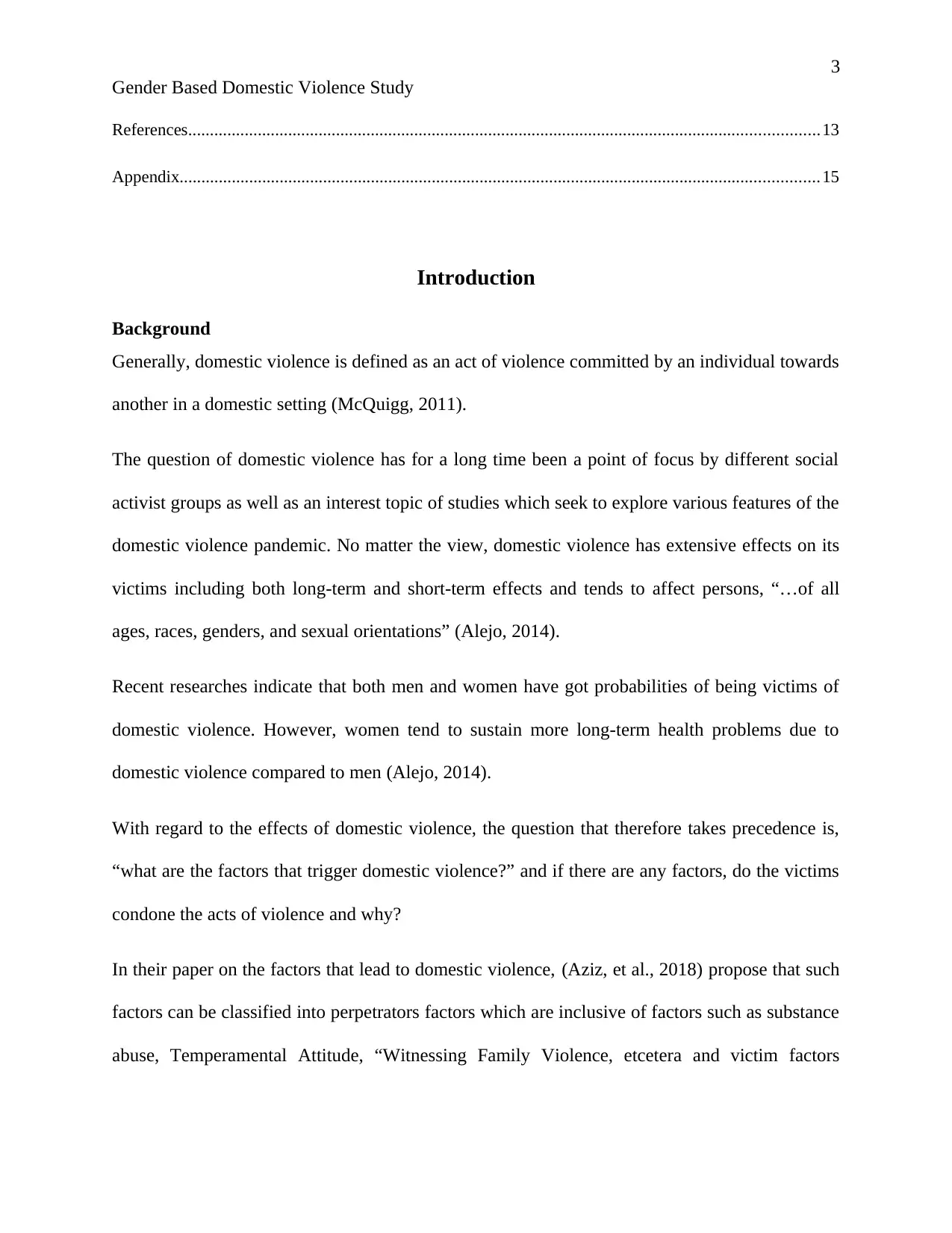
3
Gender Based Domestic Violence Study
References.................................................................................................................................................13
Appendix...................................................................................................................................................15
Introduction
Background
Generally, domestic violence is defined as an act of violence committed by an individual towards
another in a domestic setting (McQuigg, 2011).
The question of domestic violence has for a long time been a point of focus by different social
activist groups as well as an interest topic of studies which seek to explore various features of the
domestic violence pandemic. No matter the view, domestic violence has extensive effects on its
victims including both long-term and short-term effects and tends to affect persons, “…of all
ages, races, genders, and sexual orientations” (Alejo, 2014).
Recent researches indicate that both men and women have got probabilities of being victims of
domestic violence. However, women tend to sustain more long-term health problems due to
domestic violence compared to men (Alejo, 2014).
With regard to the effects of domestic violence, the question that therefore takes precedence is,
“what are the factors that trigger domestic violence?” and if there are any factors, do the victims
condone the acts of violence and why?
In their paper on the factors that lead to domestic violence, (Aziz, et al., 2018) propose that such
factors can be classified into perpetrators factors which are inclusive of factors such as substance
abuse, Temperamental Attitude, “Witnessing Family Violence, etcetera and victim factors
Gender Based Domestic Violence Study
References.................................................................................................................................................13
Appendix...................................................................................................................................................15
Introduction
Background
Generally, domestic violence is defined as an act of violence committed by an individual towards
another in a domestic setting (McQuigg, 2011).
The question of domestic violence has for a long time been a point of focus by different social
activist groups as well as an interest topic of studies which seek to explore various features of the
domestic violence pandemic. No matter the view, domestic violence has extensive effects on its
victims including both long-term and short-term effects and tends to affect persons, “…of all
ages, races, genders, and sexual orientations” (Alejo, 2014).
Recent researches indicate that both men and women have got probabilities of being victims of
domestic violence. However, women tend to sustain more long-term health problems due to
domestic violence compared to men (Alejo, 2014).
With regard to the effects of domestic violence, the question that therefore takes precedence is,
“what are the factors that trigger domestic violence?” and if there are any factors, do the victims
condone the acts of violence and why?
In their paper on the factors that lead to domestic violence, (Aziz, et al., 2018) propose that such
factors can be classified into perpetrators factors which are inclusive of factors such as substance
abuse, Temperamental Attitude, “Witnessing Family Violence, etcetera and victim factors
⊘ This is a preview!⊘
Do you want full access?
Subscribe today to unlock all pages.

Trusted by 1+ million students worldwide
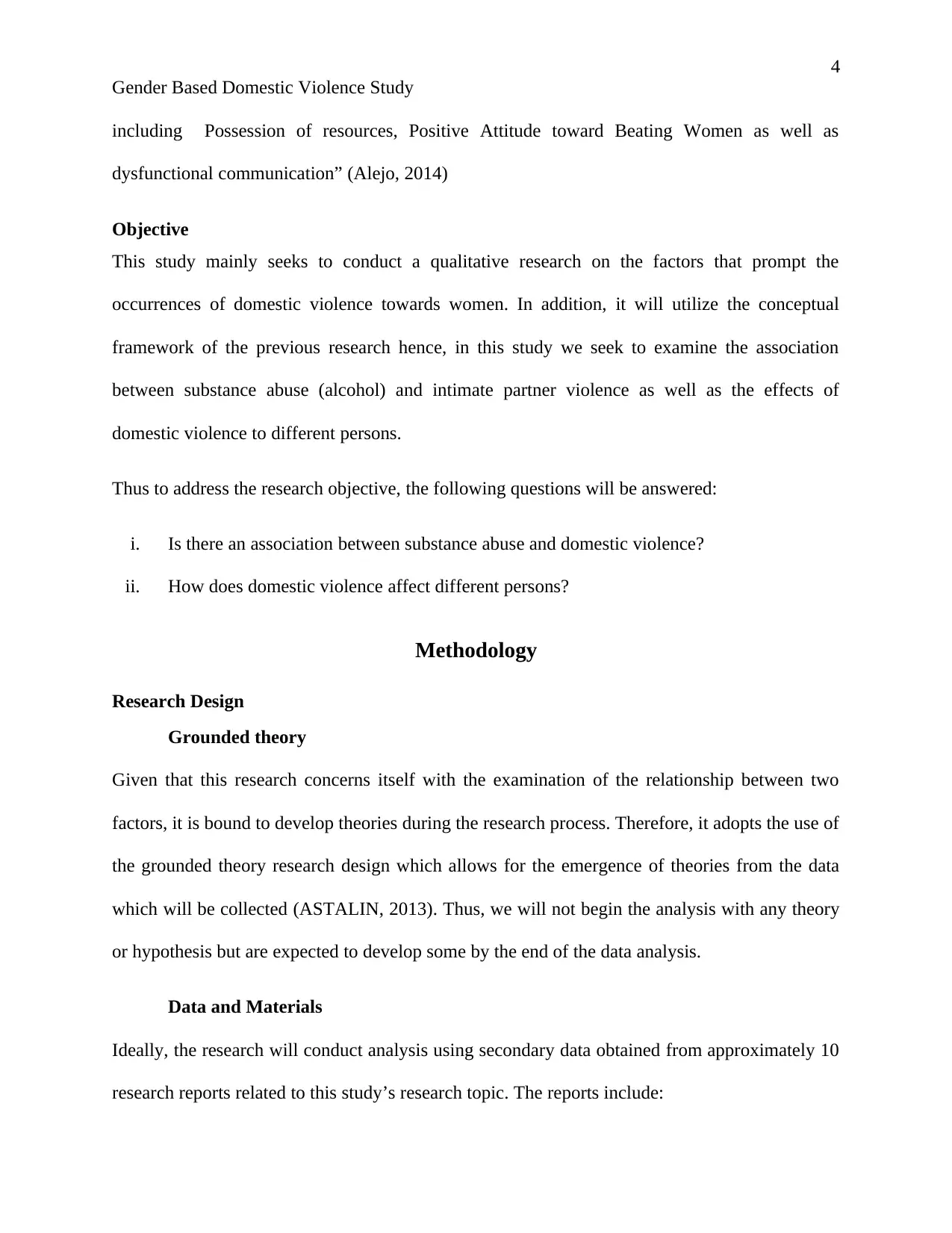
4
Gender Based Domestic Violence Study
including Possession of resources, Positive Attitude toward Beating Women as well as
dysfunctional communication” (Alejo, 2014)
Objective
This study mainly seeks to conduct a qualitative research on the factors that prompt the
occurrences of domestic violence towards women. In addition, it will utilize the conceptual
framework of the previous research hence, in this study we seek to examine the association
between substance abuse (alcohol) and intimate partner violence as well as the effects of
domestic violence to different persons.
Thus to address the research objective, the following questions will be answered:
i. Is there an association between substance abuse and domestic violence?
ii. How does domestic violence affect different persons?
Methodology
Research Design
Grounded theory
Given that this research concerns itself with the examination of the relationship between two
factors, it is bound to develop theories during the research process. Therefore, it adopts the use of
the grounded theory research design which allows for the emergence of theories from the data
which will be collected (ASTALIN, 2013). Thus, we will not begin the analysis with any theory
or hypothesis but are expected to develop some by the end of the data analysis.
Data and Materials
Ideally, the research will conduct analysis using secondary data obtained from approximately 10
research reports related to this study’s research topic. The reports include:
Gender Based Domestic Violence Study
including Possession of resources, Positive Attitude toward Beating Women as well as
dysfunctional communication” (Alejo, 2014)
Objective
This study mainly seeks to conduct a qualitative research on the factors that prompt the
occurrences of domestic violence towards women. In addition, it will utilize the conceptual
framework of the previous research hence, in this study we seek to examine the association
between substance abuse (alcohol) and intimate partner violence as well as the effects of
domestic violence to different persons.
Thus to address the research objective, the following questions will be answered:
i. Is there an association between substance abuse and domestic violence?
ii. How does domestic violence affect different persons?
Methodology
Research Design
Grounded theory
Given that this research concerns itself with the examination of the relationship between two
factors, it is bound to develop theories during the research process. Therefore, it adopts the use of
the grounded theory research design which allows for the emergence of theories from the data
which will be collected (ASTALIN, 2013). Thus, we will not begin the analysis with any theory
or hypothesis but are expected to develop some by the end of the data analysis.
Data and Materials
Ideally, the research will conduct analysis using secondary data obtained from approximately 10
research reports related to this study’s research topic. The reports include:
Paraphrase This Document
Need a fresh take? Get an instant paraphrase of this document with our AI Paraphraser
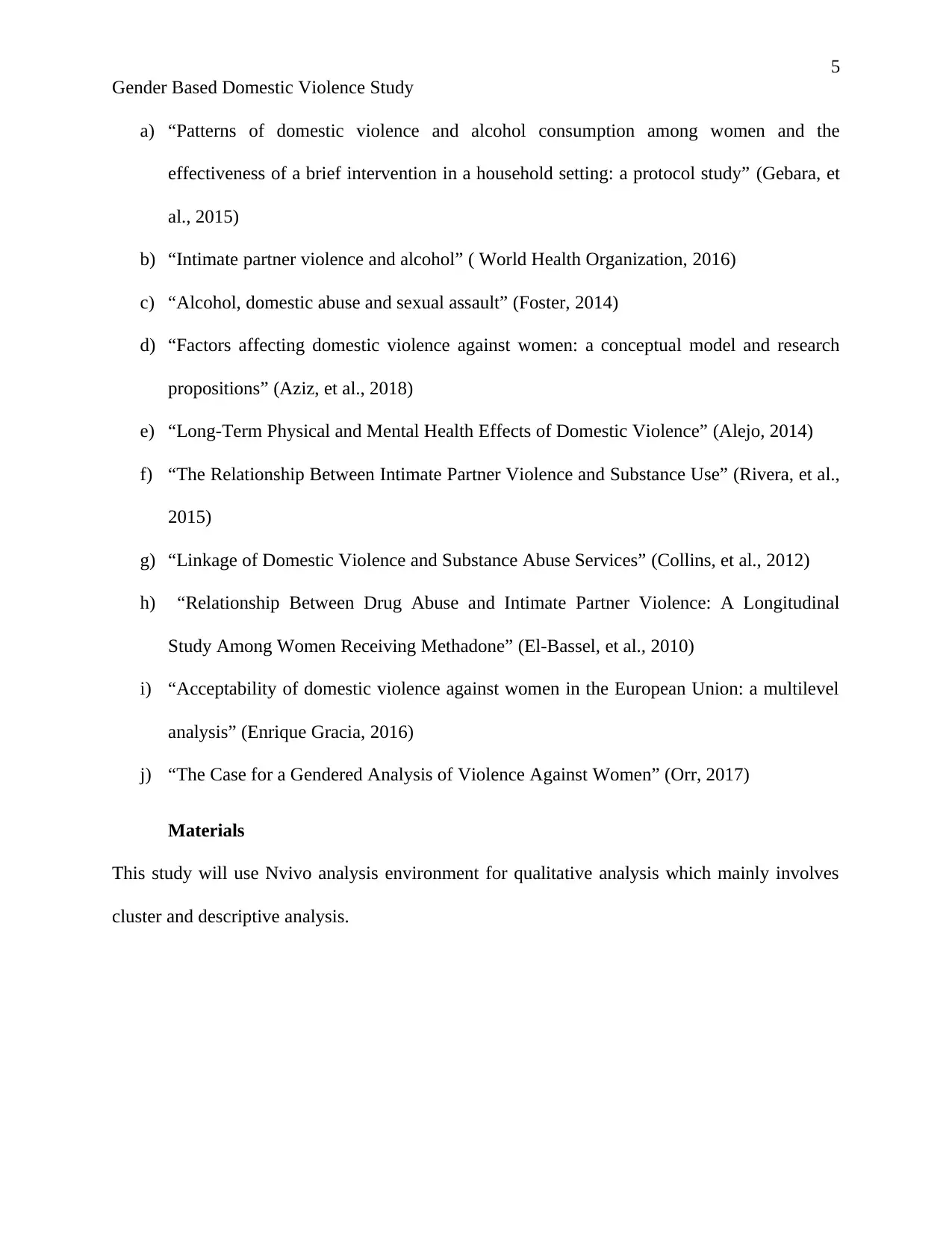
5
Gender Based Domestic Violence Study
a) “Patterns of domestic violence and alcohol consumption among women and the
effectiveness of a brief intervention in a household setting: a protocol study” (Gebara, et
al., 2015)
b) “Intimate partner violence and alcohol” ( World Health Organization, 2016)
c) “Alcohol, domestic abuse and sexual assault” (Foster, 2014)
d) “Factors affecting domestic violence against women: a conceptual model and research
propositions” (Aziz, et al., 2018)
e) “Long-Term Physical and Mental Health Effects of Domestic Violence” (Alejo, 2014)
f) “The Relationship Between Intimate Partner Violence and Substance Use” (Rivera, et al.,
2015)
g) “Linkage of Domestic Violence and Substance Abuse Services” (Collins, et al., 2012)
h) “Relationship Between Drug Abuse and Intimate Partner Violence: A Longitudinal
Study Among Women Receiving Methadone” (El-Bassel, et al., 2010)
i) “Acceptability of domestic violence against women in the European Union: a multilevel
analysis” (Enrique Gracia, 2016)
j) “The Case for a Gendered Analysis of Violence Against Women” (Orr, 2017)
Materials
This study will use Nvivo analysis environment for qualitative analysis which mainly involves
cluster and descriptive analysis.
Gender Based Domestic Violence Study
a) “Patterns of domestic violence and alcohol consumption among women and the
effectiveness of a brief intervention in a household setting: a protocol study” (Gebara, et
al., 2015)
b) “Intimate partner violence and alcohol” ( World Health Organization, 2016)
c) “Alcohol, domestic abuse and sexual assault” (Foster, 2014)
d) “Factors affecting domestic violence against women: a conceptual model and research
propositions” (Aziz, et al., 2018)
e) “Long-Term Physical and Mental Health Effects of Domestic Violence” (Alejo, 2014)
f) “The Relationship Between Intimate Partner Violence and Substance Use” (Rivera, et al.,
2015)
g) “Linkage of Domestic Violence and Substance Abuse Services” (Collins, et al., 2012)
h) “Relationship Between Drug Abuse and Intimate Partner Violence: A Longitudinal
Study Among Women Receiving Methadone” (El-Bassel, et al., 2010)
i) “Acceptability of domestic violence against women in the European Union: a multilevel
analysis” (Enrique Gracia, 2016)
j) “The Case for a Gendered Analysis of Violence Against Women” (Orr, 2017)
Materials
This study will use Nvivo analysis environment for qualitative analysis which mainly involves
cluster and descriptive analysis.
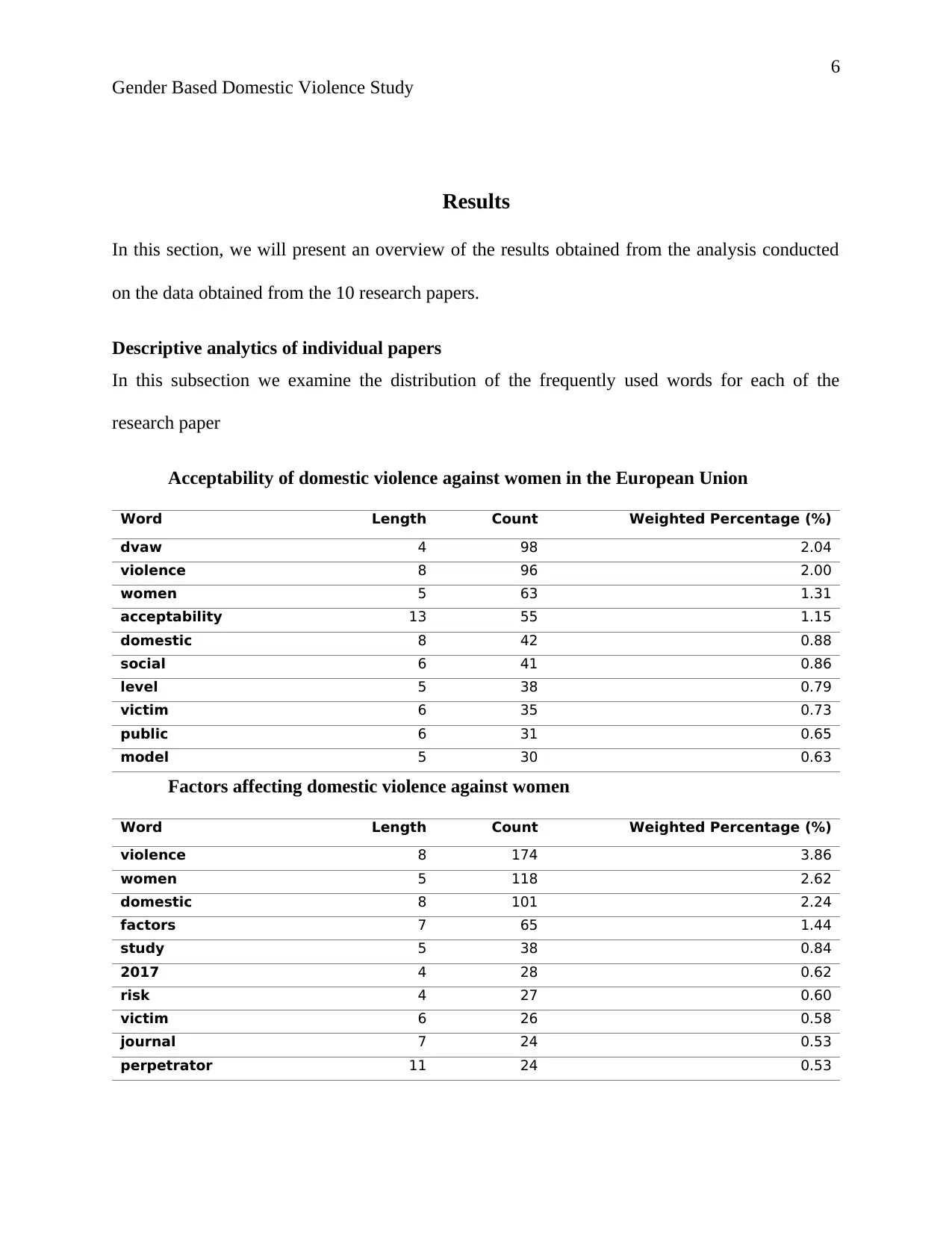
6
Gender Based Domestic Violence Study
Results
In this section, we will present an overview of the results obtained from the analysis conducted
on the data obtained from the 10 research papers.
Descriptive analytics of individual papers
In this subsection we examine the distribution of the frequently used words for each of the
research paper
Acceptability of domestic violence against women in the European Union
Word Length Count Weighted Percentage (%)
dvaw 4 98 2.04
violence 8 96 2.00
women 5 63 1.31
acceptability 13 55 1.15
domestic 8 42 0.88
social 6 41 0.86
level 5 38 0.79
victim 6 35 0.73
public 6 31 0.65
model 5 30 0.63
Factors affecting domestic violence against women
Word Length Count Weighted Percentage (%)
violence 8 174 3.86
women 5 118 2.62
domestic 8 101 2.24
factors 7 65 1.44
study 5 38 0.84
2017 4 28 0.62
risk 4 27 0.60
victim 6 26 0.58
journal 7 24 0.53
perpetrator 11 24 0.53
Gender Based Domestic Violence Study
Results
In this section, we will present an overview of the results obtained from the analysis conducted
on the data obtained from the 10 research papers.
Descriptive analytics of individual papers
In this subsection we examine the distribution of the frequently used words for each of the
research paper
Acceptability of domestic violence against women in the European Union
Word Length Count Weighted Percentage (%)
dvaw 4 98 2.04
violence 8 96 2.00
women 5 63 1.31
acceptability 13 55 1.15
domestic 8 42 0.88
social 6 41 0.86
level 5 38 0.79
victim 6 35 0.73
public 6 31 0.65
model 5 30 0.63
Factors affecting domestic violence against women
Word Length Count Weighted Percentage (%)
violence 8 174 3.86
women 5 118 2.62
domestic 8 101 2.24
factors 7 65 1.44
study 5 38 0.84
2017 4 28 0.62
risk 4 27 0.60
victim 6 26 0.58
journal 7 24 0.53
perpetrator 11 24 0.53
⊘ This is a preview!⊘
Do you want full access?
Subscribe today to unlock all pages.

Trusted by 1+ million students worldwide
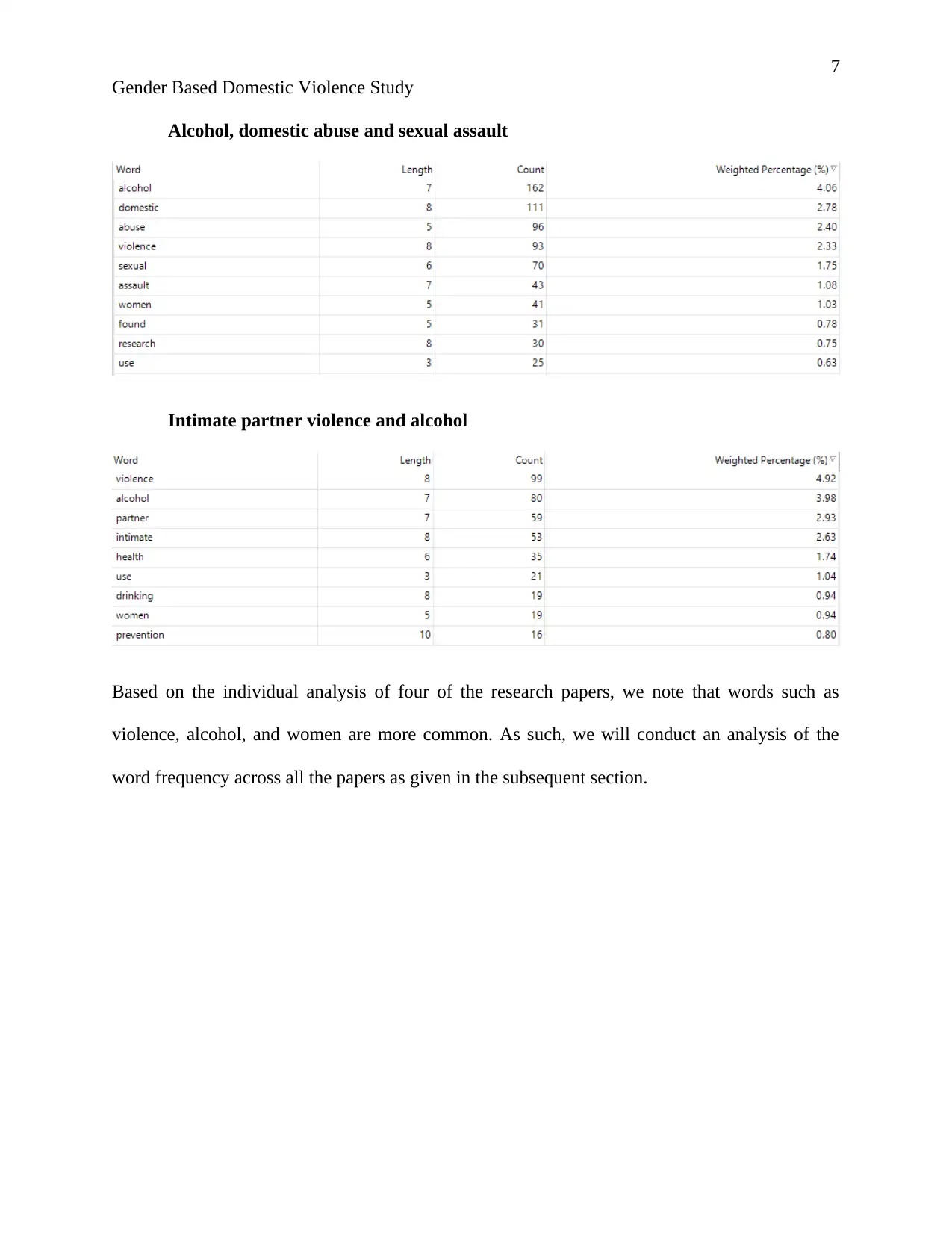
7
Gender Based Domestic Violence Study
Alcohol, domestic abuse and sexual assault
Intimate partner violence and alcohol
Based on the individual analysis of four of the research papers, we note that words such as
violence, alcohol, and women are more common. As such, we will conduct an analysis of the
word frequency across all the papers as given in the subsequent section.
Gender Based Domestic Violence Study
Alcohol, domestic abuse and sexual assault
Intimate partner violence and alcohol
Based on the individual analysis of four of the research papers, we note that words such as
violence, alcohol, and women are more common. As such, we will conduct an analysis of the
word frequency across all the papers as given in the subsequent section.
Paraphrase This Document
Need a fresh take? Get an instant paraphrase of this document with our AI Paraphraser
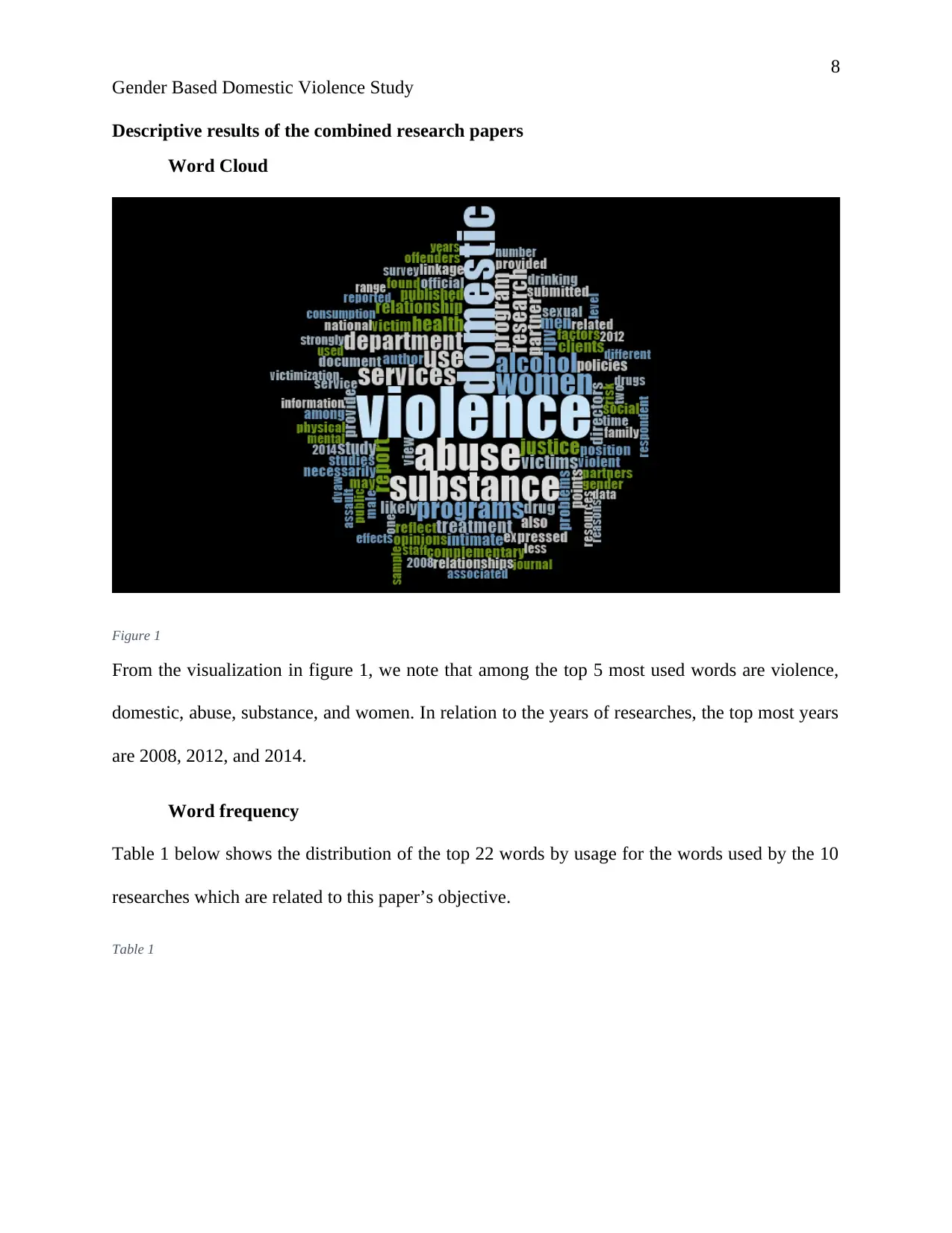
8
Gender Based Domestic Violence Study
Descriptive results of the combined research papers
Word Cloud
Figure 1
From the visualization in figure 1, we note that among the top 5 most used words are violence,
domestic, abuse, substance, and women. In relation to the years of researches, the top most years
are 2008, 2012, and 2014.
Word frequency
Table 1 below shows the distribution of the top 22 words by usage for the words used by the 10
researches which are related to this paper’s objective.
Table 1
Gender Based Domestic Violence Study
Descriptive results of the combined research papers
Word Cloud
Figure 1
From the visualization in figure 1, we note that among the top 5 most used words are violence,
domestic, abuse, substance, and women. In relation to the years of researches, the top most years
are 2008, 2012, and 2014.
Word frequency
Table 1 below shows the distribution of the top 22 words by usage for the words used by the 10
researches which are related to this paper’s objective.
Table 1
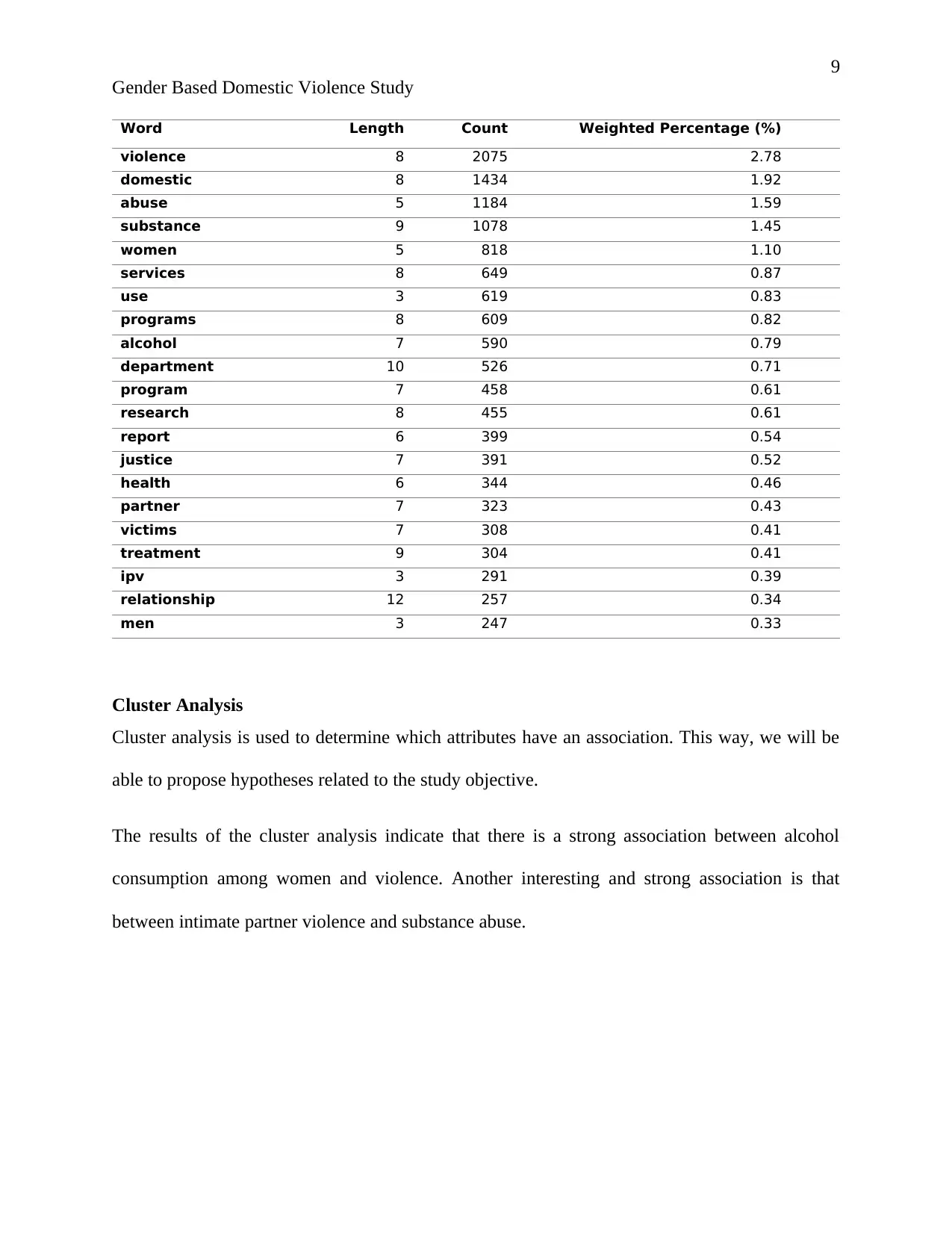
9
Gender Based Domestic Violence Study
Word Length Count Weighted Percentage (%)
violence 8 2075 2.78
domestic 8 1434 1.92
abuse 5 1184 1.59
substance 9 1078 1.45
women 5 818 1.10
services 8 649 0.87
use 3 619 0.83
programs 8 609 0.82
alcohol 7 590 0.79
department 10 526 0.71
program 7 458 0.61
research 8 455 0.61
report 6 399 0.54
justice 7 391 0.52
health 6 344 0.46
partner 7 323 0.43
victims 7 308 0.41
treatment 9 304 0.41
ipv 3 291 0.39
relationship 12 257 0.34
men 3 247 0.33
Cluster Analysis
Cluster analysis is used to determine which attributes have an association. This way, we will be
able to propose hypotheses related to the study objective.
The results of the cluster analysis indicate that there is a strong association between alcohol
consumption among women and violence. Another interesting and strong association is that
between intimate partner violence and substance abuse.
Gender Based Domestic Violence Study
Word Length Count Weighted Percentage (%)
violence 8 2075 2.78
domestic 8 1434 1.92
abuse 5 1184 1.59
substance 9 1078 1.45
women 5 818 1.10
services 8 649 0.87
use 3 619 0.83
programs 8 609 0.82
alcohol 7 590 0.79
department 10 526 0.71
program 7 458 0.61
research 8 455 0.61
report 6 399 0.54
justice 7 391 0.52
health 6 344 0.46
partner 7 323 0.43
victims 7 308 0.41
treatment 9 304 0.41
ipv 3 291 0.39
relationship 12 257 0.34
men 3 247 0.33
Cluster Analysis
Cluster analysis is used to determine which attributes have an association. This way, we will be
able to propose hypotheses related to the study objective.
The results of the cluster analysis indicate that there is a strong association between alcohol
consumption among women and violence. Another interesting and strong association is that
between intimate partner violence and substance abuse.
⊘ This is a preview!⊘
Do you want full access?
Subscribe today to unlock all pages.

Trusted by 1+ million students worldwide
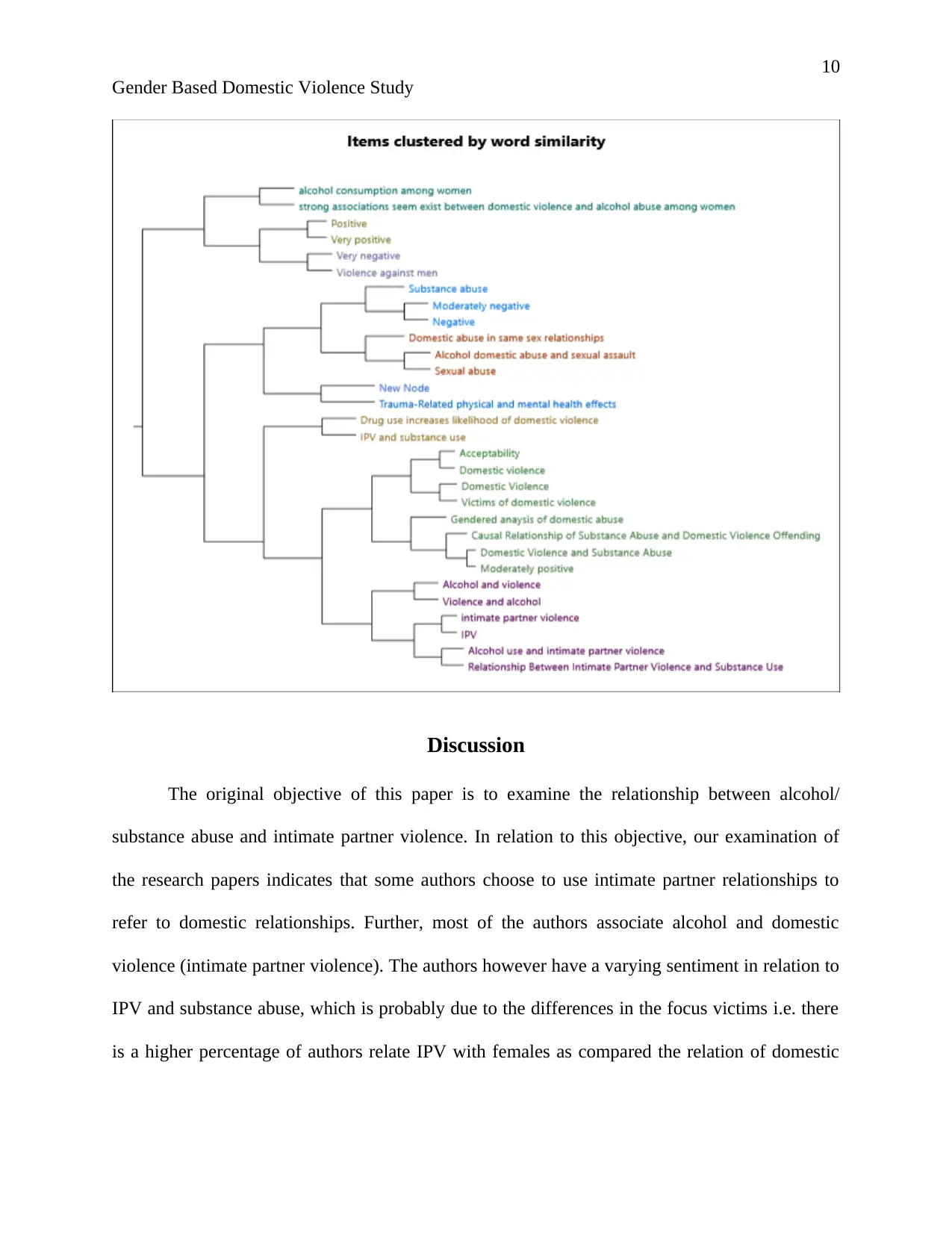
10
Gender Based Domestic Violence Study
Discussion
The original objective of this paper is to examine the relationship between alcohol/
substance abuse and intimate partner violence. In relation to this objective, our examination of
the research papers indicates that some authors choose to use intimate partner relationships to
refer to domestic relationships. Further, most of the authors associate alcohol and domestic
violence (intimate partner violence). The authors however have a varying sentiment in relation to
IPV and substance abuse, which is probably due to the differences in the focus victims i.e. there
is a higher percentage of authors relate IPV with females as compared the relation of domestic
Gender Based Domestic Violence Study
Discussion
The original objective of this paper is to examine the relationship between alcohol/
substance abuse and intimate partner violence. In relation to this objective, our examination of
the research papers indicates that some authors choose to use intimate partner relationships to
refer to domestic relationships. Further, most of the authors associate alcohol and domestic
violence (intimate partner violence). The authors however have a varying sentiment in relation to
IPV and substance abuse, which is probably due to the differences in the focus victims i.e. there
is a higher percentage of authors relate IPV with females as compared the relation of domestic
Paraphrase This Document
Need a fresh take? Get an instant paraphrase of this document with our AI Paraphraser
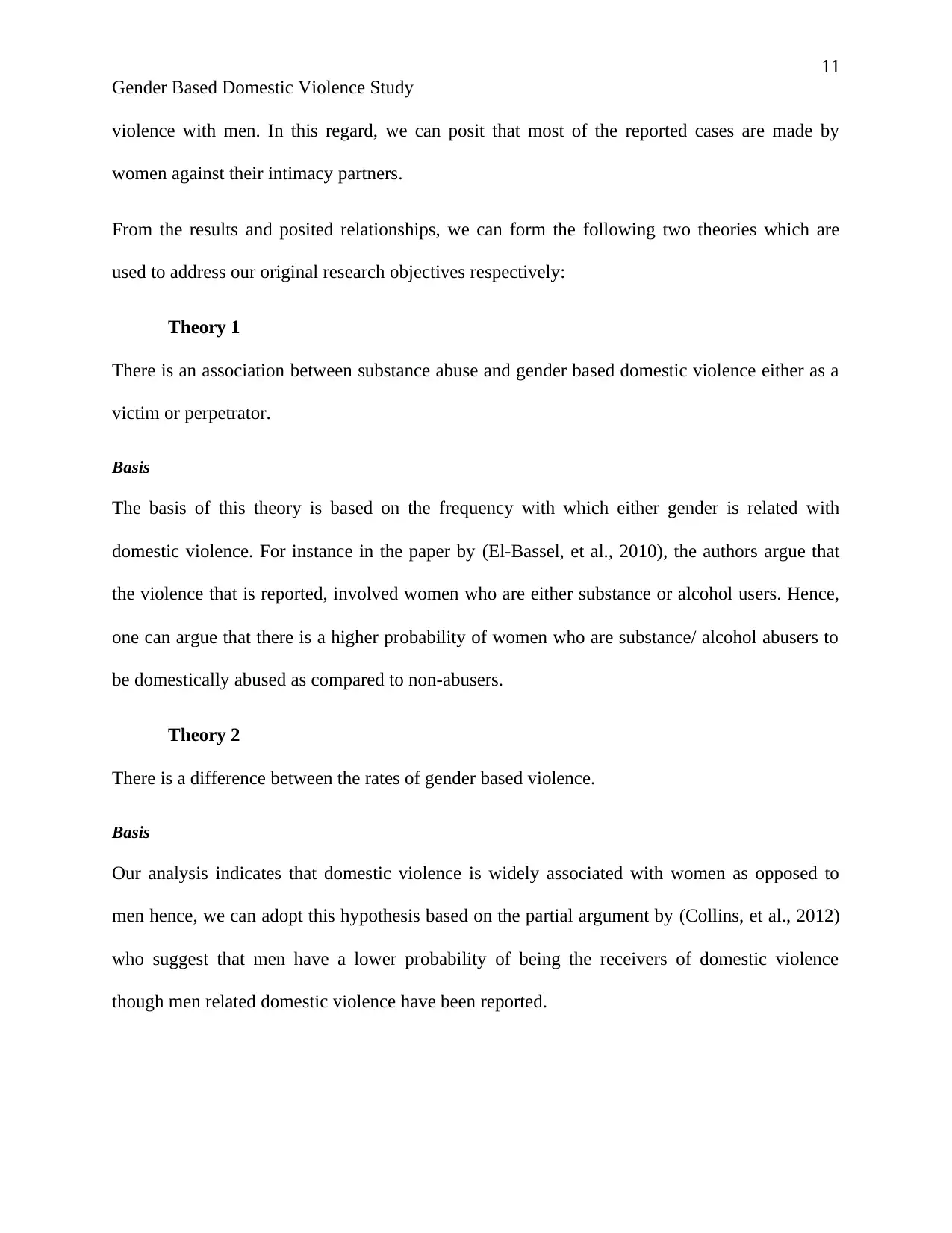
11
Gender Based Domestic Violence Study
violence with men. In this regard, we can posit that most of the reported cases are made by
women against their intimacy partners.
From the results and posited relationships, we can form the following two theories which are
used to address our original research objectives respectively:
Theory 1
There is an association between substance abuse and gender based domestic violence either as a
victim or perpetrator.
Basis
The basis of this theory is based on the frequency with which either gender is related with
domestic violence. For instance in the paper by (El-Bassel, et al., 2010), the authors argue that
the violence that is reported, involved women who are either substance or alcohol users. Hence,
one can argue that there is a higher probability of women who are substance/ alcohol abusers to
be domestically abused as compared to non-abusers.
Theory 2
There is a difference between the rates of gender based violence.
Basis
Our analysis indicates that domestic violence is widely associated with women as opposed to
men hence, we can adopt this hypothesis based on the partial argument by (Collins, et al., 2012)
who suggest that men have a lower probability of being the receivers of domestic violence
though men related domestic violence have been reported.
Gender Based Domestic Violence Study
violence with men. In this regard, we can posit that most of the reported cases are made by
women against their intimacy partners.
From the results and posited relationships, we can form the following two theories which are
used to address our original research objectives respectively:
Theory 1
There is an association between substance abuse and gender based domestic violence either as a
victim or perpetrator.
Basis
The basis of this theory is based on the frequency with which either gender is related with
domestic violence. For instance in the paper by (El-Bassel, et al., 2010), the authors argue that
the violence that is reported, involved women who are either substance or alcohol users. Hence,
one can argue that there is a higher probability of women who are substance/ alcohol abusers to
be domestically abused as compared to non-abusers.
Theory 2
There is a difference between the rates of gender based violence.
Basis
Our analysis indicates that domestic violence is widely associated with women as opposed to
men hence, we can adopt this hypothesis based on the partial argument by (Collins, et al., 2012)
who suggest that men have a lower probability of being the receivers of domestic violence
though men related domestic violence have been reported.
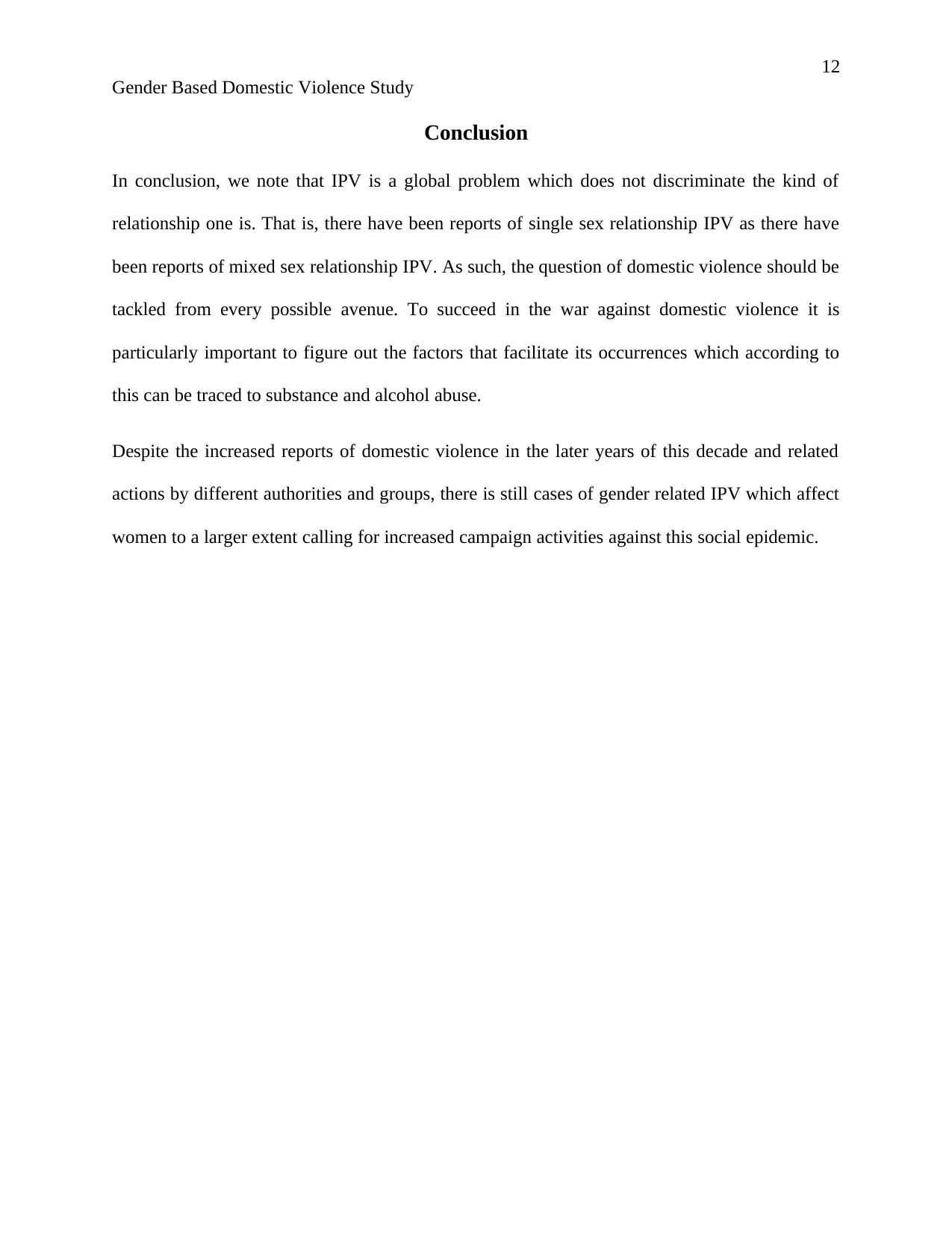
12
Gender Based Domestic Violence Study
Conclusion
In conclusion, we note that IPV is a global problem which does not discriminate the kind of
relationship one is. That is, there have been reports of single sex relationship IPV as there have
been reports of mixed sex relationship IPV. As such, the question of domestic violence should be
tackled from every possible avenue. To succeed in the war against domestic violence it is
particularly important to figure out the factors that facilitate its occurrences which according to
this can be traced to substance and alcohol abuse.
Despite the increased reports of domestic violence in the later years of this decade and related
actions by different authorities and groups, there is still cases of gender related IPV which affect
women to a larger extent calling for increased campaign activities against this social epidemic.
Gender Based Domestic Violence Study
Conclusion
In conclusion, we note that IPV is a global problem which does not discriminate the kind of
relationship one is. That is, there have been reports of single sex relationship IPV as there have
been reports of mixed sex relationship IPV. As such, the question of domestic violence should be
tackled from every possible avenue. To succeed in the war against domestic violence it is
particularly important to figure out the factors that facilitate its occurrences which according to
this can be traced to substance and alcohol abuse.
Despite the increased reports of domestic violence in the later years of this decade and related
actions by different authorities and groups, there is still cases of gender related IPV which affect
women to a larger extent calling for increased campaign activities against this social epidemic.
⊘ This is a preview!⊘
Do you want full access?
Subscribe today to unlock all pages.

Trusted by 1+ million students worldwide
1 out of 15
Related Documents
Your All-in-One AI-Powered Toolkit for Academic Success.
+13062052269
info@desklib.com
Available 24*7 on WhatsApp / Email
![[object Object]](/_next/static/media/star-bottom.7253800d.svg)
Unlock your academic potential
Copyright © 2020–2025 A2Z Services. All Rights Reserved. Developed and managed by ZUCOL.



